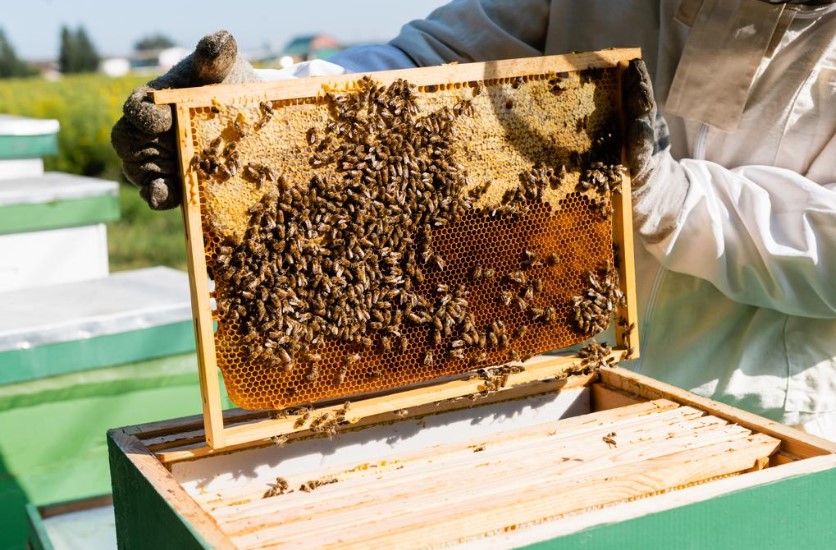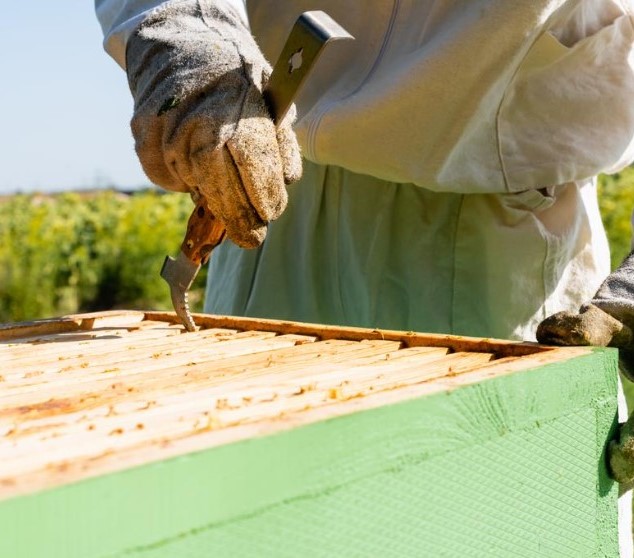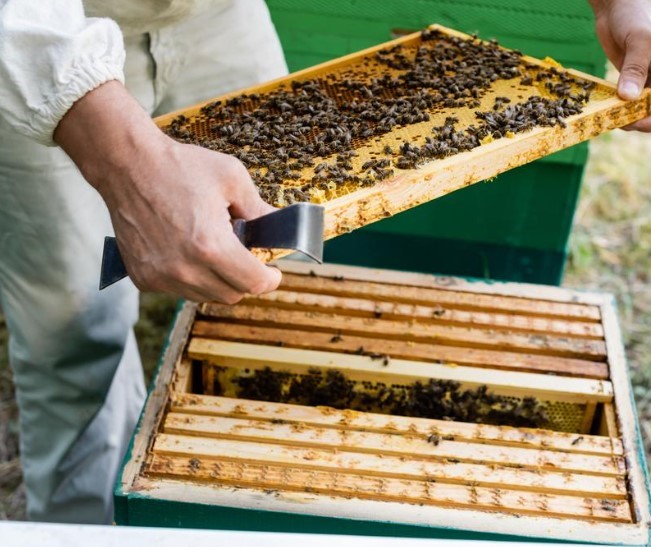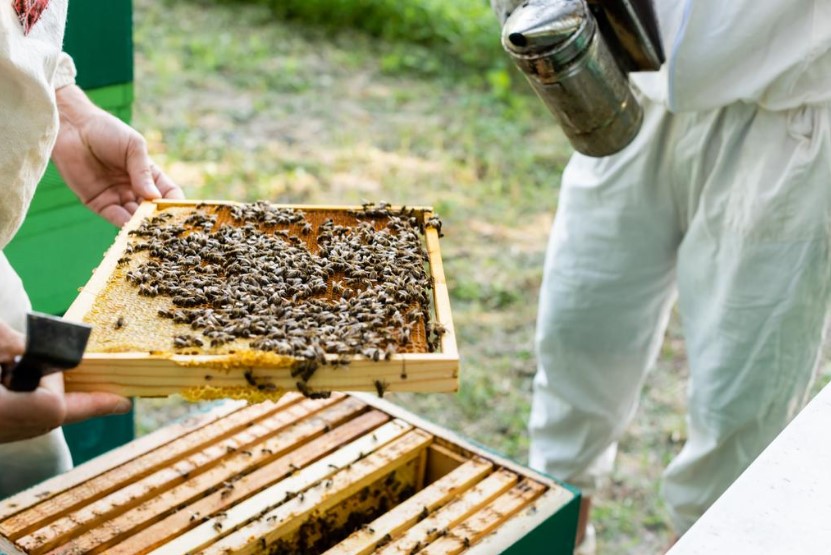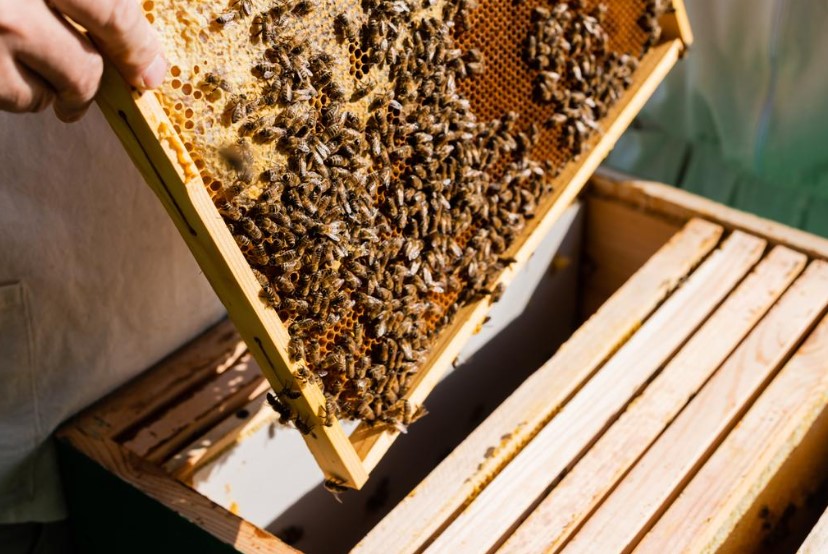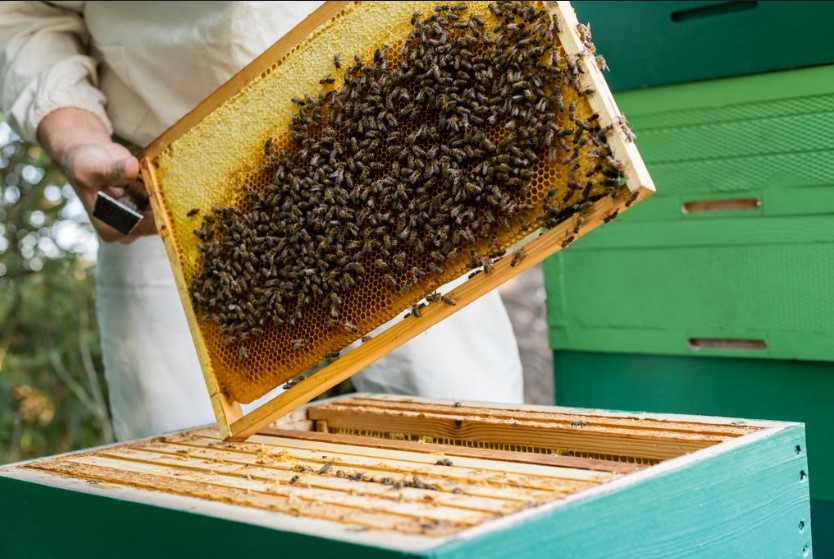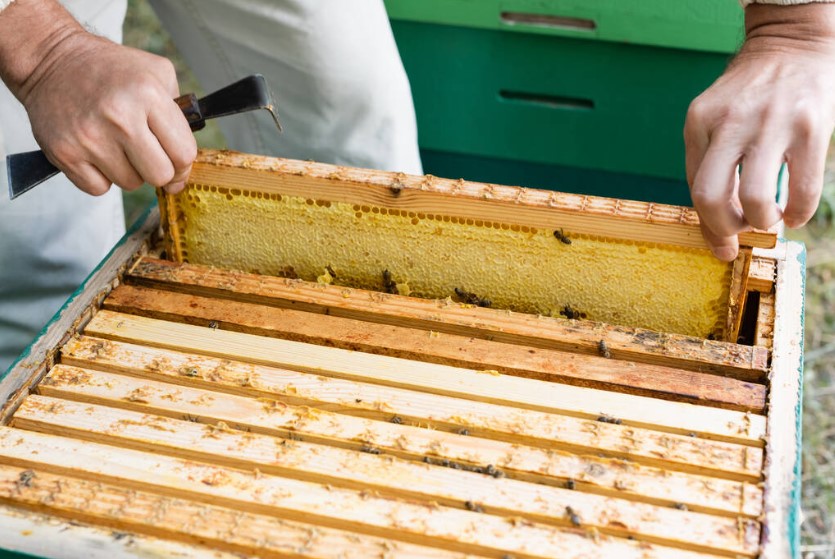Beehive Frames
Join our beekeeping community and gain access to expert advice on frame selection, maintenance, and more. Don’t miss out – sign up now and beekeep like a pro!
Maintaining Beehive Frames for Healthy Colonies: Tips and Best Practices
Table of Contents
- 1 Beehive Frames
- 1.1 Maintaining Beehive Frames for Healthy Colonies: Tips and Best Practices
- 1.2 Key Features About Beehive Frames
- 1.3 Types of Beehive Frames
- 1.4 Materials Used in Beehive Frames
- 1.5 Using Foundation with Beehive Frames
- 1.6 Customizing Beehive Frames
- 1.7 Ventilation for Beehive Frames
- 1.8 Inspecting Beehive Frames for Bee Health
- 1.8.1 Harvesting Honey from Beehive Frames
- 1.8.2 Pest Control for Beehive Frames
- 1.8.3 Winterizing Beehive Frames
- 1.8.4 Promoting Desired Bee Behavior
- 1.8.5 The Role of the Queen Bee
- 1.8.6 Brood Development in Beehive Frames
- 1.8.7 Factors Influencing Honey Production
- 1.8.8 Using Propolis Collected from Beehive Frames
- 1.8.9 Collecting Pollen from Beehive Frames
- 1.8.10 Utilizing Beeswax from Beehive Frames
- 1.8.11 Beekeeping Accessories for Beehive Frames
- 1.8.12 Seeking Expert Advice on Beehive Frames
- 1.9 Conclusion
- 1.10 BEEHIVE FRAMES – FAQs
- 1.10.1 What are the different types of beehive frames?
- 1.10.2 How do I assemble beehive frames?
- 1.10.3 What are the ideal dimensions for beehive frames?
- 1.10.4 How do I install beehive frames in my hive?
- 1.10.5 What's the best way to maintain beehive frames?
- 1.10.6 What's the ideal spacing between beehive frames?
- 1.10.7 Do I need to use foundation with beehive frames?
- 1.10.8 Can I design custom beehive frames?
- 1.10.9 What materials are commonly used for beehive frames?
- 1.10.10 How do I inspect beehive frames for bee health?
- 1.10.11 What's the importance of hive frame ventilation?
- 1.10.12 When and how should I harvest honey from beehive frames?
- 1.10.13 How do I protect my beehive frames from pests?
- 1.10.14 What should I do if my beehive frames have wax moth infestations?
- 1.10.15 How can I prevent ants from invading my beehive frames?
- 1.10.16 What's the best way to winterize beehive frames?
- 1.10.17 How can I encourage proper bee behavior around beehive frames?
- 1.10.18 What's the role of a queen bee in beehive frames?
- 1.10.19 How do I promote brood development in beehive frames?
- 1.10.20 What factors influence honey production in beehive frames?
- 1.10.21 Can I use propolis collected from beehive frames?
- 1.10.22 What are the benefits of collecting pollen from beehive frames?
- 1.10.23 How can I make the most of beeswax collected from beehive frames?
- 1.10.24 Are there specific beekeeping accessories for beehive frames?
- 1.10.25 Where can I find expert advice on beehive frames?
Beehive frames are essential components in the world of beekeeping, serving as the structural foundation upon which thriving bee colonies are built. These frames provide support, organization, and guidance to the intricate lives of bees. There are several types of beehive frames available, each tailored to specific beekeeping methods. For instance, Langstroth frames are the standard choice, known for their rectangular shape and versatility in both brood and honey supers. On the other hand, top bar frames offer a simpler design with a single bar atop which bees construct comb naturally. Deep and medium frames cater to specific hive needs, with deep frames primarily used for brood rearing and medium frames for honey storage.
The materials used in constructing beehive frames are diverse, allowing beekeepers to select the most suitable option for their needs. Wood, often chosen for its durability and insulation properties, is a classic choice. However, plastic frames have gained popularity due to their lightweight nature and resistance to moisture. Foundation sheets made of either beeswax or plastic play a crucial role in guiding bees in constructing comb within the frames, adding structural stability to the hive. Assembling and maintaining beehive frames correctly is vital for the overall health and productivity of bee colonies, making them a cornerstone of successful beekeeping practices.
Key Features About Beehive Frames
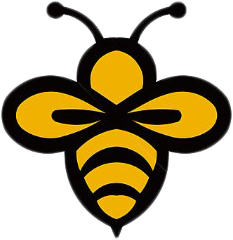
Structural Support: Beehive frames provide the necessary structure and support for beehives, ensuring their stability and durability.

Honey Production: Frames are integral to honey production, as they hold the comb where bees store honey.

Colony Management: Beekeepers use frames to manage colonies, inspect bee activity, and monitor bee health.

Types and Varieties: Frames come in various types, including Langstroth frames, top bar frames, deep and medium frames, catering to different beekeeping methods.

Materials: Frames can be made of wood or plastic, each offering its own benefits and considerations.

Assembly: Beekeepers assemble frames by fitting together components like sidebars, top bars, and foundation, following manufacturer instructions.

Installation: Frames are inserted into hive bodies or supers, ensuring proper spacing and security within the hive.

Maintenance: Regular maintenance involves inspecting frames for damage, cleaning, and replacing worn-out components to ensure hive health.

Spacing: Proper frame spacing is crucial for bee movement and colony growth, typically around 1⅜ inches for Langstroth frames.

Foundation: Beeswax or plastic foundation sheets provide guidance for comb construction and structural stability.

Customization: Beekeepers can customize frames to suit specific hive designs and preferences, allowing for flexibility in hive management.

Ventilation: Adequate ventilation options, including screened bottom boards and top ventilation systems, help regulate hive temperature and humidity.

Pest Control: Implementing pest control measures protects colonies from threats like mites and wax moths.

Harvesting Honey: Frames play a central role in honey harvesting, with methods such as honey extraction or crushing and straining.

Winterization: Proper winterization involves insulating hives and reducing entrances to ensure bees survive the winter.

Behavior Promotion: Frame management, spacing, and resource provision can encourage desired bee behavior, supporting colony health.

Role of the Queen Bee: The queen bee’s presence is vital for colony reproduction and stability, making her role central to hive success.

Brood Development: Adequate food, space, and a suitable environment are crucial for healthy brood development, impacting overall colony health.

Factors Influencing Honey Production: Nectar availability, hive health, and bee foraging activity are factors that influence honey production.

Secondary Bee Products: Frames can yield secondary bee products like propolis, pollen, and beeswax, each with its own uses and benefits.

Beekeeping Accessories: Various accessories like bee brushes, frame holders, and frame pullers aid in frame management and beekeeping tasks.

Expert Guidance: Beekeepers can seek advice and knowledge from experienced beekeepers, online forums, and beekeeping associations.
Types of Beehive Frames
Langstroth Frames
Standard and widely used frames measuring 19 inches long and 9⅛ inches tall.
Top Bar Frames
Simpler frames with a single bar on top for comb attachment.
Deep Hive Frames
Deeper frames used in brood boxes for raising worker bees.
Medium Hive Frames
Intermediate-sized frames for honey storage and brood.
Materials Used in Beehive Frames
Wood
Commonly used for traditional frames, offering durability and insulation.
Plastic
Lightweight and durable alternative to wooden frames.
Foundation
Sheets of beeswax or plastic that guide bees in comb construction.
Assembling Beehive Frames
- Follow manufacturer instructions for frame assembly.
- Typically, frames consist of sidebars, top bars, and foundation.
- Use nails or frame pins to secure components together.
Installing Beehive Frames
- Insert frames into hive bodies or supers.
- Maintain proper spacing (usually 1⅜ inches for Langstroth frames) to allow bee movement.
- Ensure frames are level and secure within the hive.
Maintaining Beehive Frames
- Regularly inspect frames for signs of damage or wear.
- Replace worn-out frames or damaged foundation to maintain hive health.
- Clean frames as needed to remove propolis, wax, and debris.
Join our beekeeping community and gain access to expert advice on frame selection, maintenance, and more.
Don’t miss out – sign up now and beekeep like a pro!”
Using Foundation with Beehive Frames

Foundation sheets provide a guide for bees to build comb.

Options include beeswax foundation or plastic foundation.

Foundation aids in structural stability within the hive.
Customizing Beehive Frames

Beekeepers can customize frames to suit specific hive designs and preferences.

Modifications may include altering frame dimensions or adding features like handles.
Ventilation for Beehive Frames

Proper ventilation helps regulate hive temperature and humidity.

Ventilation options include screened bottom boards and top ventilation systems.
Inspecting Beehive Frames for Bee Health

Regular inspections are essential to monitor colony health.

Look for signs of disease, pest infestations, and overall bee activity.
Harvesting Honey from Beehive Frames
- Honey harvesting timing depends on the season and honey flow.
- Common methods include honey extraction or crushing and straining.
Pest Control for Beehive Frames
- Implement pest control measures to protect bee colonies.
- Use screen bottom boards, traps, and regular inspections to manage pests.
Winterizing Beehive Frames
- Winterize hives by insulating them and reducing entrances.
- Ensure bees have sufficient food stores to survive the winter.
Promoting Desired Bee Behavior
- Proper frame management, spacing, and resource provision can encourage desired bee behavior.
- This includes maintaining a healthy hive environment and colony.
The Role of the Queen Bee
- The queen bee is essential for laying eggs, contributing to colony reproduction, and maintaining hive stability.
- A healthy queen is crucial for colony success.
Brood Development in Beehive Frames
- Adequate food, space, and a suitable environment are essential for healthy brood development.
- Beekeepers monitor brood patterns to assess colony health.
Factors Influencing Honey Production
- Honey production depends on factors like nectar availability, hive health, and bee foraging activity.
- Proper management and resources support optimal honey production.
Using Propolis Collected from Beehive Frames
Propolis has various uses, including as a natural adhesive, antimicrobial agent, and medicinal substance.
Collecting Pollen from Beehive Frames
Pollen collection can provide essential nutrients for bee colonies and has potential health benefits for humans.
Utilizing Beeswax from Beehive Frames
Beeswax can be used for making candles, cosmetics, and a variety of craft projects.
Beekeeping Accessories for Beehive Frames
Accessories like bee brushes, frame holders, and frame pullers aid in frame management and beekeeping tasks.
Seeking Expert Advice on Beehive Frames
Beekeepers can seek guidance from experienced beekeepers, online forums, and beekeeping associations for valuable insights and tips.
Conclusion
Beehive frames play a critical role in successful beekeeping operations, providing support for colonies and facilitating honey production. Understanding the different types, materials, assembly, and maintenance is essential for beekeepers to ensure the health and productivity of their hives. By following best practices and staying informed, beekeepers can create thriving bee colonies and enjoy the rewards of honey production.
BEEHIVE FRAMES – FAQs
What are the different types of beehive frames?
Beehive frames come in various types, including Langstroth frames, top bar frames, and deep and medium frames, each designed for specific beekeeping methods.
How do I assemble beehive frames?
Assembling beehive frames typically involves fitting together the frame components, such as sidebars and foundation, following manufacturer instructions.
What are the ideal dimensions for beehive frames?
Standard Langstroth frames are usually 19 inches long and 9⅛ inches tall, while dimensions can vary for other frame types.
How do I install beehive frames in my hive?
Beehive frames are installed by inserting them into the hive body or super, ensuring proper spacing for bee activity.
What's the best way to maintain beehive frames?
Regular maintenance includes inspecting frames for damage, cleaning, and replacing worn-out components as needed.
What's the ideal spacing between beehive frames?
Frame spacing should be approximately 1⅜ inches for Langstroth frames, allowing bees to move freely.
Do I need to use foundation with beehive frames?
Using foundation helps guide bees in building comb and can provide structural support for the hive.
Can I design custom beehive frames?
Yes, you can customize frames to meet specific beekeeping requirements and hive designs.
What materials are commonly used for beehive frames?
Wood and plastic are the most common materials, each with its own advantages and considerations.
How do I inspect beehive frames for bee health?
Inspect frames for signs of disease, pest infestations, and overall bee activity to assess colony health.
What's the importance of hive frame ventilation?
Proper ventilation helps regulate hive temperature and humidity, contributing to bee comfort and colony health.
When and how should I harvest honey from beehive frames?
Honey harvesting depends on the season, and you can use various methods such as extraction or crushing and straining.
How do I protect my beehive frames from pests?
Implement pest control measures such as screen bottom boards, traps, and regular inspections.
What should I do if my beehive frames have wax moth infestations?
Remove infested frames, freeze them to kill the moths, and store them in a clean, dry place.
How can I prevent ants from invading my beehive frames?
Use ant moats or barriers, keeping the hive stand clear of vegetation, and ensure there are no food sources nearby.
What's the best way to winterize beehive frames?
Insulate the hive, reduce entrances, and ensure bees have sufficient food stores for the winter.
How can I encourage proper bee behavior around beehive frames?
Frame management, proper spacing, and adequate resources can promote desired bee behavior.
What's the role of a queen bee in beehive frames?
The queen bee lays eggs, and her presence is crucial for the colony’s reproduction and stability.
How do I promote brood development in beehive frames?
Maintain a healthy colony with ample food and a suitable environment to support brood growth.
What factors influence honey production in beehive frames?
Honey production depends on factors like nectar availability, hive health, and bee foraging activity.
Can I use propolis collected from beehive frames?
Yes, propolis has various uses, including as a natural adhesive or medicinal substance.
What are the benefits of collecting pollen from beehive frames?
Pollen collection can provide valuable nutrients for bee colonies and has potential health benefits for humans.
How can I make the most of beeswax collected from beehive frames?
Beeswax can be used for candles, cosmetics, and various craft projects.
Are there specific beekeeping accessories for beehive frames?
Yes, accessories like bee brushes, frame holders, and frame pullers can aid in frame management.
Where can I find expert advice on beehive frames?
You can seek guidance from experienced beekeepers, online forums, and beekeeping associations for valuable insights and tips.


